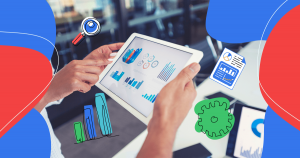Are you tired of guessing your marketing game and hoping for the best? It’s time to unlock the full potential of your marketing efforts with AI-backed predictive analytics!
It is no secret that businesses today cannot succeed without data. However, just collecting tons of data is not the answer. What’s important is deriving valuable insights from them to make informed decisions. That’s where predictive analytics and AI come in.
Predictive AI comes near to accurately predicting your customers’ behaviors and preferences, so you no longer have to rely on guesswork. By crunching through mountains of data, AI algorithms uncover hidden patterns and trends that drive consumer decision-making.
This knowledge empowers you to tailor your marketing precisely to each customer’s needs, increasing the chances of customer response. Interesting? Wait, there’s more!
Read on to understand AI predictive analysis in detail and uncover the various opportunities it brings to marketers.
Download this post by entering your email below
How Does AI Predictive Analysis Work?
AI predictive analysis uses advanced algorithms, machine learning, and statistical models to analyze data and find patterns that might predict future outcomes. These tools can predict trends and behavior happening the next second, day, or even years into the future.
Most companies have a big pile of data about their customers—things like their:
- Purchase history,
- Past interaction with the brand,
- Demographic information,
- Social media activity, and
- Website browsing patterns.
AI algorithms dive into this data, looking for hidden patterns and connections. Let’s break this down with the help of an example.
AI predictive analysis in practice
Suppose you own an online fitness store and want to predict which fitness accessories your customers will likely purchase. The AI predictive analysis algorithms would delve into their data, examining factors like their previous purchases, fitness goals, and even the workouts they engage in.
For instance, the algorithms might discover that customers who frequently buy yoga mats are also interested in purchasing resistance bands. With this insight, you can create targeted promotions or suggest bundle deals for customers who purchase a yoga mat, offering them a discount on resistance bands to enhance their workout routine.
Furthermore, the AI algorithms also consider external factors like customer reviews, social media discussions, or fitness influencer recommendations.
For example, suppose a fitness accessory gains popularity due to positive influencer reviews or endorsements. In that case, the algorithms might suggest highlighting that product and offering special promotions to capitalize on the buzz.
AI Predictive Analysis Opportunity For Marketing
As you may have guessed, predictive analysis potential in marketing are many. Here are some ways businesses can harness its potential:
Customer behavior prediction
Understanding and predicting customer behavior is essential for businesses today. It helps them clearly understand what their customers want and need. That’s where AI predictive analysis comes in.
With AI algorithms, businesses can dig into past data like previous purchases, browsing habits, and even demographic information. By looking at all this historical stuff, the algorithms can figure out patterns and predict what customers might purchase next.
With this knowledge, you can offer personalized recommendations and special deals as the final push for customers to convert. In a way, you’re giving them what they want even before they know it themselves.
Such predictions help companies better understand their customers and create experiences that make them go, “Wow!”
As per the 2023 State of Social Media report, 45% of leaders believe using predictive analytics to indicate future customer behavior will be an essential AI application.
Personalized marketing campaigns
As a marketer, wouldn’t you like your customers to feel that your marketing campaign was made just for them? AI predictive analysis makes this possible.
They analyze your customers’ browsing history and past purchases and, based on that, deliver personalized messages that grab their attention. An example of this is sending personalized email recommendations that make your customers tick. It would be wise to use the perfect newsletter templates so that it becomes easier for the customer to make a decision.
And guess what? They actually work! A recent report finds that personalized emails with a business email address can generate a 139% more click rate.
When companies use AI predictive analysis, they unlock a whole new world of personalized marketing. They can make real connections with customers instead of just blasting generic messages.
Demand forecasting
Demand forecasting is a big challenge for business executives today. Although data collection has increased for businesses, purchase patterns have become equally complex. This has made it difficult to predict trends.
The problem with traditional demand forecasting is that they’re only as good as the data and people interpreting it. AI-powered demand forecasting is a better solution. AI algorithms can spot patterns, find hidden relationships in massive datasets, and even pick up on signals that indicate changes in demand.
This is not to say that AI demand forecasting is 100% accurate. However, they can help companies significantly reduce supply chain inefficiencies and improve their financial planning.
According to Mckinsey, applying AI-based forecasting to the supply chain can reduce product unavailability by 65%, cut warehouse cost by 5-10%, and reduce administration cost by 25-40%.
Optimal pricing strategies
Another useful application of predictive AI in business is determining the optimal price for your products and services.
Dynamic pricing is common in industries such as hospitability and tourism, where fluctuating demand determines pricing. It helps businesses stay competitive and profitable.
Companies in these sectors can quickly respond to market dynamics to optimize their revenue by using AI. AI predictive tools analyze historical and real-time data (e.g., market data, competitor pricing, and customer behavior trends).
This helps companies set the right price, balancing attracting customers and generating revenue.
Customer lifetime value prediction
Knowing a customer’s lifetime value is gold. It means businesses can put their resources where they matter most. They can make personalized offers, create special experiences, and do whatever it takes to keep those customers returning.
Why is this important? Because 65% of a brand’s purchases come from repeat customers. And your loyal customers pay 33% more on average for your brand.
AI predictive analysis can be a game-changer in this area. It helps companies determine how valuable a customer is in the long run by looking at their interaction with the business and loyalty to the brand.
A good example of this is AI in subscription-based services. AI-backed predictive tools identify customers likely to stick around based on their usage patterns and engagement level. It helps subscription businesses prioritize retention strategies to keep their best customers happy.
Churn prediction and customer retention
To sustain a healthy business, understanding why customers leave and what can be done to bring them back is crucial. This process is called churn prediction.
With AI-powered churn modeling, businesses can predict which customers will likely switch to competitors. This valuable insight helps your retention team proactively retain those customers through personalized offers, improved customer experiences, or targeted marketing campaigns.
As we have already seen, losing loyal customers can be costly. AI predictive models provide a tremendous opportunity for businesses to save money by reducing customer churn.
Sentiment analysis and brand reputation management
Sentiment analysis is another important application of predictive AI. In today’s digital age, managing reputation has been more important than ever. And this is only possible by closely monitoring how people feel about your product and services.
You need to dive into social media conversations, customer reviews, and online reviews. And what better technology to do this than sentiment analysis?
With sentiment analysis, you can keep a close eye on online reviews and quickly respond to negative feedback. This shows that you care about customer satisfaction and allows you to turn things around and win back unhappy customers.
Marketing for Content Creation and Optimization
AI predictive analysis offers exciting opportunities for marketing in the realm of content creation and optimization. By leveraging advanced algorithms and natural language processing, AI can aid marketers in various aspects of content production.
It starts with topic and keyword research, identifying trending themes and popular search queries. AI can even help come up with ideas for content, from articles to social media posts, adhering to specific guidelines.
In fact, you can create AI-driven outlines with our new AI Content Wizard.
Personalization is enhanced as AI analyzes user data to deliver tailored content recommendations. Moreover, AI predicts content performance before publishing, guiding marketers to make informed decisions. Content distribution, promotion, and A/B testing can all be optimized through AI automation.
Content curation tools enable the gathering and organization of relevant content from diverse sources. Additionally, sentiment analysis helps gauge audience reception, while SEO optimization boosts organic search rankings. Lastly, text-to-video AI facilitates transforming written content into a video for wider international reach.
Overall, integrating AI predictive analysis streamlines content creation, making it data-driven, efficient, and more impactful for marketers.
Cross-selling and upselling opportunities
Understanding your customers better also improves your opportunity for cross-selling and upselling. When you have real-time data on customer preferences, you can recommend complementary or upgraded products likely to catch their interest and increase the order value.
A large part of the success of these opportunities lies in providing highly personalized recommendations. For instance, when you add an item to your cart when shopping online, you are often suggested “Customers who bought this also bought…” recommendations.
Those suggestions are made possible by collaborative filtering algorithms powered by AI.
Using AI predictive analysis for upselling and cross-selling boosts the average value for each purchase. It also enhances customers’ shopping experience by recommending products they might have missed otherwise.
Conclusion
AI-backed predictive analysis opens up a world of marketing opportunities for businesses. The ability to anticipate customer needs and tailor strategies accordingly gives businesses a competitive edge in today’s dynamic market.
However, implementing AI in marketing strategies does come with its challenges. Data privacy and ethical concerns must be addressed to ensure responsible use of customer data. Additionally, companies need the right infrastructure and skilled professionals who can effectively understand and interpret AI-driven insights.
Looking forward, the future of AI-backed predictive analysis is promising. As AI technologies evolve and become more sophisticated, we can expect more accurate predictions and deeper insights into customer behavior.
AI will play a significant role in hyper-personalization, allowing businesses to deliver tailored experiences that resonate with individual customers. Moreover, AI will empower marketers to make real-time decisions, swiftly responding to market changes and customer needs.
As the AI landscape evolves, collaboration between humans and machines will become increasingly important. The human touch in marketing, such as creativity and emotional intelligence, combined with the analytical power of AI, will drive marketing strategies forward.
It is an exciting time for AI-backed predictive analysis, and businesses that embrace this technology will be well-positioned to thrive in the future of marketing.

Written by Ankit Solanki
As a Tech investor, I loved finding promising tech startups and helping them grow. But I started feeling like a spectator at a soccer game and I wanted to be on the field! One of my portfolio companies, InVideo, took a risk and offered me a playground to test my skills and expertise in building startups. When I’m not busy growing the company, you’ll find me writing about tech, Artificial Intelligence, growth, and investing – and sometimes, sneaking in a game of soccer.

![[ROCK NA] [EBOOK SEO] Complete Guide](https://rockcontent.com/wp-content/uploads/2024/06/banner_Search-Engine-Optimization.png)






